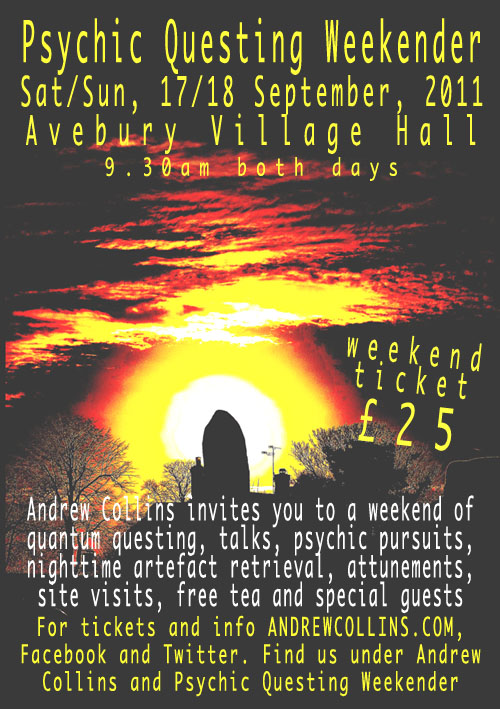![]()
![]()
South
Africa's Enigmatic
Stone Ruins Explored
Adam's
Calendar, near Mpumalanga in South Africa
It is one of the hottest subjects in the ancient mysteries subject today. What is Adam's Calendar? Is it really the oldest stone circle in the world? Was it really made by the Annunaki, the alien gods of the Sumerians, as a home base in their quest for earthly gold some 200,000 years ago? Or is it just 75,000 years old, made as a stone calendar aligned to the sun, moon and stars?
In
March 2011 I attended the first Megalithomania
conference in South Africa, where I joined Adam's Calendar experts Michael
Tellinger and Johan Heine, as they attempt to convince me of the site's extreme
antiquity. I also explore just a few of the hundreds of thousands of ancient stone
ruins dismissed by archaeologists as cattle kraals, pens for cattle, even though
they might well have much deeper meanings behind their construction.
After leaving Houston, Texas, on March 7th, 2011, I flew via London Heathrow airport to Johannesburg, where I was picked up from the airport on Wednesday, March 9th, 2011, by none other than Michael Tellinger, who already had in the car Kerry Cassidy of Project Camelot, the every popular online TV network dedicated to the more wayward mysteries of life.
Michael drove us to westwards some 130 miles (215 km) to his home town of Waterval Boven, where he has invested in a bistro and bar called the Stone Circle, named after the large number of ancient stone ruins found scattered about the local hills. These are made up of circles of dry-stone walling, which are themselves broken up into various cells, lobes and apses. They are mostly unclassified, although officially they are considered cattles kraals, i.e. pens for cattle attached to living habitation.
Even though I had now gone without sleep for more than 48 hours, it was to be an eventful day, for I was informed that a helicopter, an ex-US Army Iroquois that had seen action in the Vietnam War, was on its way to pick up myself and other speakers and guests for the upcoming Megalithomania South Africa conference, in order that we might see some of these ancient ruins for ourselves.
The thought of flying in a helicopter filled me with dread, as I have a thing about heights and I was pretty sure that it was going to take off with its side doors open in order to make filming easy. I was not wrong, so somewhat hesitantly I climbed onboard, strapped myself into a hot seat next to the door and held on for grim life as the yellow chopper, which belongs to a regional fire fighting company, lifted into the air. It climbed to perhaps 1,000 feet before heading towards the local hills, where some of the most impressive ancient ruins are to be seen.

The
ex-US Army Iroquois that took us up over the ancient
stone ruins and flew us
out to Adam's Calendar
From the air they looked impressive, no doubt about that. Johan Heine, the owner of the fire fighting company and founder of the MaKomati Foundation, which is dedicated to preserving these ruins, has established that many of the stone settings possess prominent alignments towards the rising or setting of the sun on either the equinoxes or solstices. He, along with Michael Tellinger joined us in the helicopter to point out the various sites below. Both men feel that the structures are extremely old, and dismiss any thought that they were constructed as cattle kraals, or pens. They point out that none of them have any obvious entrances into their interiors, which would make it hard for animals to go inside them.
Looking
out over the ancient stone ruins of South Africa.
Jonathan Adams of Pentos
Films braving all to get some decent footage.
Still holding on to the seat, I hesitantly clicked my camera whenever one of the ancient ruins came into view. I had no idea what to make of these structures other than the fact that they looked similar to the foundations of monuments on the Italian island of Sardinia known as nuraghes, which are officially considered defensive, but do in fact have, like the South African stone ruins, celestial alignments towards prominent moments in the solar year.
Four examples of the ancient stone ruins that seem scattered about the South African landscapein the hills above the town of Waterval Boven, where Michael Tellinger has set up a wonderful bar and bistro called Stone Circle.
Visiting
Adam's Calendar
After returning back to the Stone Circle bistro for a brief break, the helicopter took our party, the side doors closed this time, over the hills to Adam's Calendar. This is a now quite famous prehistoric stone stone in the area of Mpumalanga discovered by Johan Heine in 2005, whilst flying over the area on a mission to rescue the pilot of a ditched aircraft. In recent years it has been promoted, like the Bosnian pyramids, as the oldest human structure in the world.
Situated on a sloping cliff top facing south, the site consists of a large number of seemingly randomly scattered rock boulders, of which a small percentage have been erected to create not so much a stone circle, but what archaeologist's refer to as a stone setting. In all there are around a dozen stones that appear to be standing, including two 2.5 m slabs that stand parallel to each other in the middle of the monument.
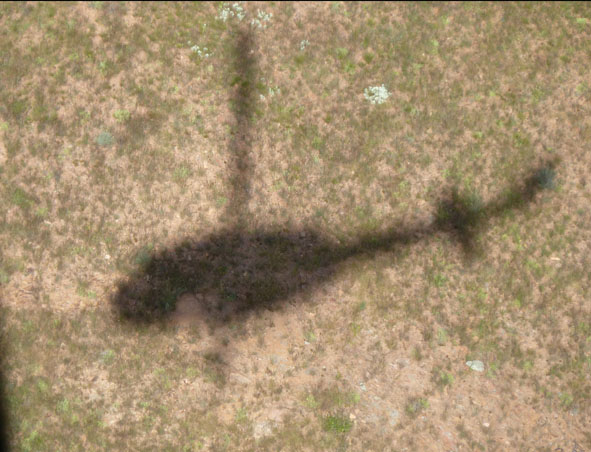 |
Above left, the helicopter's shadow. Above right, on the flight to Adam's Calendar. Visible, from right to left, Michael Tellinger, Hugh Newman, Klaus Dona, Kerry Cassidy and John Agnew.
Johan Heine talked us through various solar alignments he has detected at the site. He also points out an alignment through three recumbent stones he believes were once standing towards the belt stars of Orion. No controversy here, as Orion features in alignments at many prehistoric sites. The only problem is that John and Michael cite this particular alignment to prove that Adam's Calendar is at least 75,000 years old, since the stones only align with Orion as it would have appeared during this distant epoch of mankind.
Adam's
Calendar Created by the Annunaki 200,000 years ago?
Michael goes further by suggesting that Adam's Calendar was constructed around 200,000 years ago as a centre of operations for the Annunaki, the alien gods of the Sumerians, known also as the Nephilim. They came here from Planet Nibiru and created humanity in order that they might work on their behalf extracting gold from the earth, which was then transported back to their home planet. Adam's Calendar was the creation of the Annunaki, as were various other stone monuments locally, as well as the various ancient stone ruins seen earlier from the air. All of them were employed in the use of gold extraction, which involved a sophisticated form of sound technology and electromagnetic energy delivery, which came from nearby water sources.
 |
Above
left, John Heine, the discoverer of Adam's Calendar, and above right,
Michael
Tellinger, explaining the sound acoustics of the site.
Such ideas on Michael's part are inspired by the writings of Zecharia Sitchin, who in various bestselling books wrote that the Annunaki created gold mines in South Africa, where evidence of mining is said go back at last 75,000 to 80,000 years. Sitchin's source for his beliefs were a series of Sumerian and Hebrew texts, which he translated differently to anyone else who had ever looked at them. I read his book The Twelfth Planet back in 1995, and I can say categorically that in my opinion his translations of the texts are pure fantasy as I also read and commentated on many of the same texts for my own book From the Ashes of Angels (1996). In this I ably demonstrate that the Annunaki and Nephilim were names given to the founders of civilization who rose to prominence in the area of the Near East, the ancient land of Eden, around 11,000 years ago. They were not spacemen from Nibiru but quite likely flesh and blood human beings, a priestly or shamanic elite, who arrived in the region from somewhere else in the ancient world around the time of a massive cataclysm, almost certainly a comet impact. It is a subject I developed in various of my books, and am convinced of its validity, especially with the discovery in southeast Turkey in 1994 of Gobekli Tepe, the oldest stone circle complex in the world. Its existence confirms the likelihood of a highly advanced culture existing in the Near East around the end of the last Ice Age.
Above left, one of the two slim standing stones at the centre of Adam's Calendar, with Johan Heine showing its height. Above right, one of the stone slabs beyond the perimeter to the east-southeast of the stone setting, which Michael Tellinger sees as having been deliberately carved to give it the abstract appearance of a bird - a familiar totemic form in both South Africa and neighbouring Zimbabwe. He believes it orginally stood on the edge of the circle, although this will need to be confirmed with the discovery of a corresponding post hole above its position.
Three
and a Half Degree Misalignment
As evidence for his early dating of Adam's calendar, Michael cites the fact that its north-south alignment is kinked by three and half degrees. This he believes is the result of a crustal displacement, a slippage of the earth's crust over the mantle caused by some catastrophic event sometime after its construction. Similar ideas were voiced in connection with sites worldwide by Colin Wilson and Rand Flem-ath in their book The Atlantis Blueprint (2000), based on the original concept of crustal displacement proposed by American college professor and author Charles H. Hapgood.
Two views of Adam's Calendar looking roughly north-northeast (above left) and northeast (above right). The two central standing stones are very impressive indeed.
I think the problem here is that there is no hard evidence that, firstly, a crustal displacement has taken place in the last 200,000 years, and, secondly, that Adam's Calendar even bears an alignment three and a half degrees west of north (the recumbent stones on the southern side are just too jumbled and confusing to determine a true alignment.
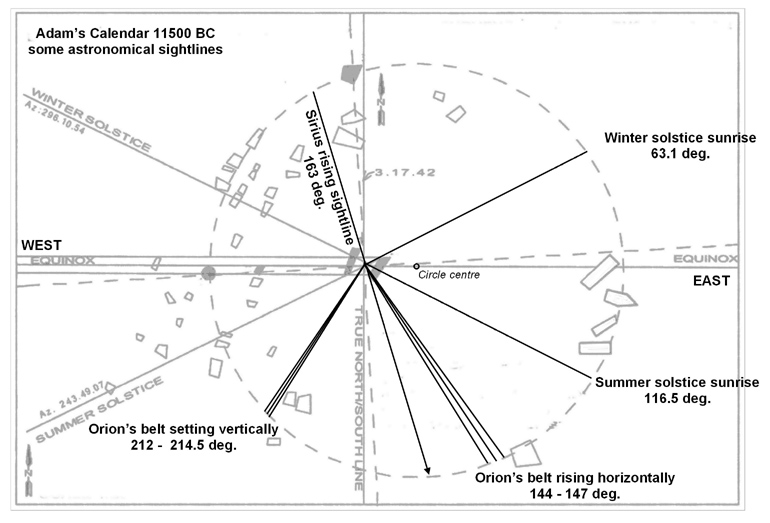
Rodney
Hale's plan of Adam's Calendar with alignments for the suggested date of 11,500
BC. This date is based on the claim that recumbent stones mark Orion's belt when
rising horizontally, providing a date of 75,000 for the site's construction. In
our current precessional cycle - which is all we can measure such a claim by -
this last occurred in 11,500 BC. However, as you can see, such an alignment doesn't
work. It hits no stones lying on the edge of the circle. Moreover, as you can
see, a 3 degree 30 minute misalignment from north is not necessary to express
the structure's curvilinear geometry. It all depends on your position in relation
to the placement of the stones. The Horus or Bird Stone as Michael Tellinger calls
it is just below east, pointing away from the centre of the circle.
I can categorically say that I have seen nothing that might convince me that Adam's Calendar was constructed beyond the currently held time-frame of megalithic construction, which began with Gobekli Tepe and the other Pre-Pottery Neolithic structures of SE Turkey and North Syria c. 10,000-9000 BC. Moreover, there is no argument that might be used to argue that any proposed alignment towards the belt stars of Orion only makes sense if the site was constructed 75,000 years ago. No calculations can be used to prove such an idea, not precession (a 26,000 year cycle), obliquity of the ecliptic (a 41,000 year cycle), or even much longer Milankovitch cycles, which only affect climate and not the earth's astronomical position against the local horizon.
It is a subject I tackled back in 2010 after meeting Michael Tellinger for the first time. I worked with technical engineer Rodney Hale in an attempt to check out Adam's Calendar stated alignments, and found no evidence whatsoever to suggest that the monument went back 75,000 years (available to anyone on request).
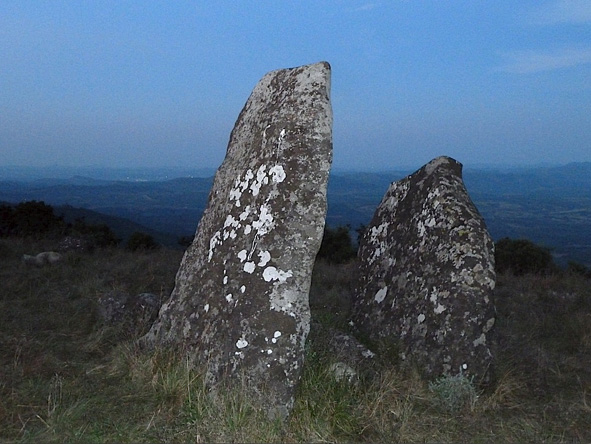 | 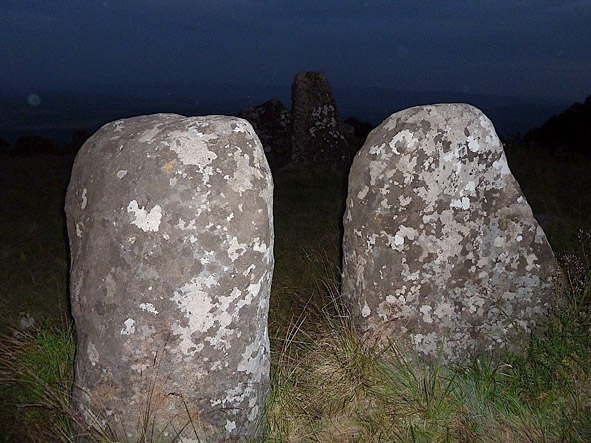 |
Above left, the two parallel standing stones at the centre of Adam's Calendar and, above right, two standing stones on the northwestern edge of the circle.
Above, a strange head-like stone unearthed at Adam's Calendar, and, right, a tall standing stone, which has been named the Standing Man. It was removed from Adam's Calendar to elsewhere in the nature reserve in order to bear a commemorative plaque. It will hopefully be restored to its original position in due course. |  |
More worrying is the fact that the stones said to mark the alignment towards Orion, do no such thing. The alignment simply doesn't work, whatever time-frame you use.
There is no question that Adam's Calendar (so named by John and Michael to determine its place as the oldest stone calendar in the world) is a fabulous site that deserves full investigation. However, to assume that this stone setting, where a number of stones have been set upright by ancient hands, goes back beyond our present evolutional cycle is simply nonsensical without any hard evidence. Using such assumptions to then go on to promote Adam's Calendar as an outpost of Zecharia Sitchin's vision of the Annunaki some 200,000 years ago is impossible to handle. These are personal beliefs that should be completely removed from any scientific exploration of the site.
I understand that Michael, Johan and their colleagues are currently in dialogue with the archaeological community to excavate Adam's Calendar, and hopefully this might result in some proper dating evidence in the future.
Two
more shots of Adam's Calendar, focusing on the twin parallel stones
near the
centre of the stone setting.
Examining
the Africa's Ancient Stone Ruins
The following day, Thursday, March 10th, our party spent the morning examining just a few of the stone ruins identified by archaeologists as cattle kraals. Each one is created using dry stone walling, which is formed into circles, cells and apses, and in some cases the walls remain as much as 2.5 metres high, suggesting that some areas of these structures once bore roofs. Often these structures come in clusters, and leading from them down to local rivers or streams are stone tracks edged with dry stone walls. Clearly, these are functional in some manner, although Michael believes they are paths used to draw energies from the water in order that the stone circles can function as magnetrons. These are high-powered vacuum tubes that generate microwaves using the interaction of a stream of electrons with a magnetic field, the internal cells of which resemble the shape of some of the ancient stone ruins. The whole purpose of these stone magnetrons would be to aid in the extraction of gold from rocks, a process he sees as occurring in the same epoch as the construction of Adam's Calendar, i.e. 200,000 years ago.
I do not have the same inclinations about the usage and great antiquity of these stone ruins, for in my opinion they were places of habitation, for both humans and animals, perhaps with a religious function associated with the various solar alignments identified by Johan Heine.
Seeing them as the work of Zecharia Sitchin's Annunaki has knock on effects. Our driver told us that a visitor to one of the stone ruins we visited that day had glimpsed a vision of a three metre tall alien being sacrificed by another three-metre tall alien inside one of the rings of dry stone. Personally I could not imagine anything like this taking place here.
Pottery
Found
At one of the stone ruins, where Michael believes that charring beneath a rock outcrop is evidence of a furnace used for metal smelting, I found a piece of pottery. It was located around the other side from the "furnace" area, deeply within a rocky niche. It is quite thick, triangular, orange-red in colour with a grey interior, and has a single groove across its outer face. I presented it to Michael, who said that he would ask a friend to identify it. However, he said that it was useless in helping to date the site as these site would have been reoccupied by tribal peoples during more recent times, and it would have been them who left behind the broken pottery. This might indeed be the case, although I do believe that the pottery shard has some age to it, and dates back to the Bantu-speaking Iron Age peoples who entered South Africa from west and central Africa some 1,800 years ago. The archaeologists attribute them with the construction of the stone ruins, although clearly more work needs to be done in order to settle the matter once and for all.
Andrew Collins holding the piece of pottery found at one of the ancient stone ruins near Waterval Boven, east of Johannesburg. It probably dates to the age of the Bantu-speaking peoples who entered South Africa from west and central Africa around 1,800 years ago.
One of the points that most struck me about the structures was the acoustic nature of the extremely hard hornfels stone used to construct them (which Michael believes was brought to the area for the express purpose of creating the monuments). He struck various examples, which rang like bells. He was even able to use one, a square table stone, to play a four-note tune (I afterwards went back to this stone and made a sound recording of the tonal sequence, which I subsequently created as a ring tone for my cell phone!).
Although I do not agree that the stone circles were sound devices in themselves, I do accept that the hard stone used to create might have been chosen for its tonal qualities (see, for instance, the story of the Musical Stones of Skiddaw http://en.wikipedia.org/wiki/Musical_Stones_of_Skiddaw).
Above left, the ancient stone ruins where the piece of pottery was discovered beneath the rock outcrop, seen towards the bottom of the picture. Above right, Michael Tellinger shows the height of the walls of one of the stone ruins, and the patina of the dry stone used, which he believes indicates the extreme age of the monument.
Is it possible that in prehistoric times humanity became aware of the acoustic qualities of certain stones, and although at first this was employed simply for recreational purposes, our ancestors went on to use sound for more functional purposes? Could sound have been used to achieve altered states of consciousness, in the same way that gongs and crystal singing bowls are used today? Did this understanding of sound eventually become an advanced technology of the type proposed by Chris Dunn as existing in ancient Egypt during dynastic times? I actually believe that such a possibility should never be dismissed out of hand.
It is with thoughts like these that I can only encourage Johan Heine and Michael Tellinger to continue their enthusiastic research into Adam's Calendar and the many other ancient stone ruins that they seek to preserve for future generations. Although I do not find anything with which to share Johan and Michael's assumed great age of these structures, they need to be properly excavated and explored to reveal their true contribution to the development of ancient technologies on the African continent.
Adam's Calendar. From left to right, Jonathan Adams of Pentos Films, Kerry Cassidy of Project Camelot, Michael Tellinger, local farmer, Johan Heine and another local land owner.
Thank you to Michael Tellinger, Johan Heine, Hugh Newman of Megalithomania, Jonathan Adams of Pentos Films, Elle Steyn and all at zuluplanet.com, and those who made us welcome at the Stone Circle bar and bistro at Waterval Boven.
For
more on Adam's Calendar and the ancient stone ruins of South Africa go to http://www.adamscalendar.com
and the website of the MaKomati
Foundation.
If this subject interests you, come to the 2011 Psychic Questing Weekender where it and many of the other subjects featured on this site will be discussed by Andrew Collins and friends
Sat
17th & Sun 18th
September 2011
QUEANTUM QUESTING + RENNES LE CHATEAU REVELATIONS + GUEST SPEAKERS + NOCTURNAL ARTEFACT RETRIEVAL + VISIT TO LOCAL SITES + FREE TEAS, COFFEES AND BISCUITS + PSYCHIC MEDITATIONS + ATTUNEMENTS + PANEL DEBATE ON PSYCHIC QUESTING + TALKS ON BOTH DAYS FROM ANDREW COLLINS, THE FOUNDER OF PSYCHIC QUESTING
Village Hall (Social Centre), High Street, Avebury, Wiltshire SN8 1RF
Opens 9.30 am each day.
Saturday finish time: 6 pm plus evening artefact retrieval
Sunday finish time: 4.30 pm
Registration:
£25 for the weekend.
Click
here for full details
Click here now for Registration
![]()
![]()
